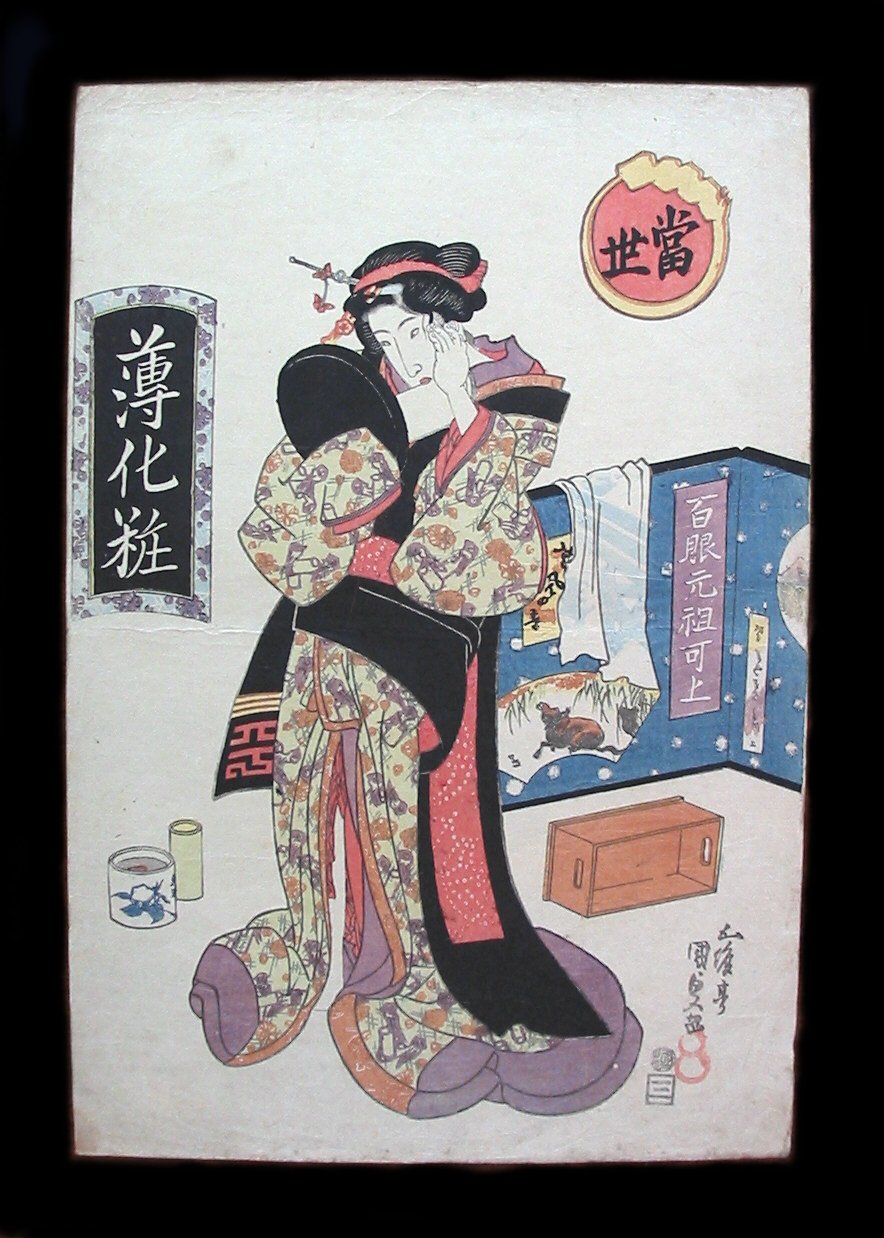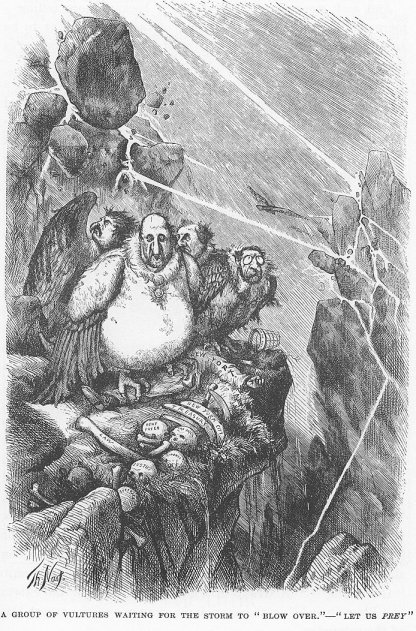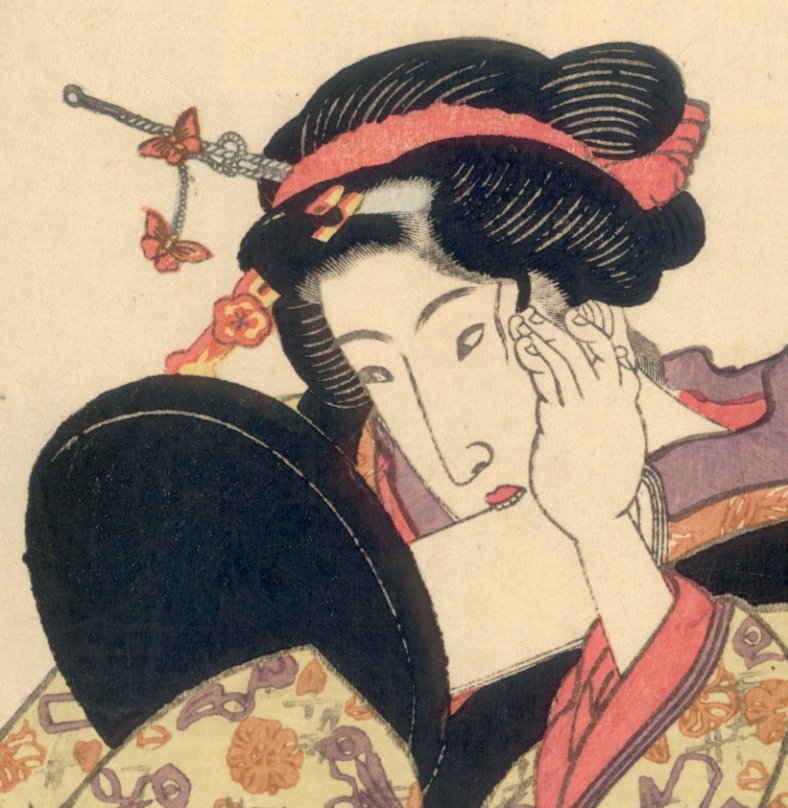

JAPANESE PRINTS
A MILLION QUESTIONS
TWO MILLION MYSTERIES
Ukiyo-e Prints浮世絵版画 |
|
Port Townsend, Washington |
|
|
UTAGAWA KUNISADA |
|
|
|
歌川国貞 |
|
|
|
うたがわくにさだ |
|
|
|
1786-1865 |
|
|
|
Series: Light Makeup of the Present Day |
|
|
|
Tōsei usugeshō |
|
|
|
当世 薄化粧 |
|
|
|
とうせい.うすげしょう |
|
|
|
Publisher: Shimizu (Andreas Marks identifies this publisher as Mikawa-ya Seiemon.) |
|
|
|
版元: 清水 |
|
|
|
はんもと: しみず |
|
|
|
Date: circa 1829 |
|
|
|
Size: 15 3/16" x 10 3/8" |
|
|
|
Signed: Gototei Kunisada ga |
|
|
|
署名: 五渡亭国貞画 |
|
|
|
しょめい: ごとていくにさだが |
|
|
|
There is another copy of this print in the collection of the Museum of Fine Arts, Boston |
|
|
|
ORIGINALLY $1,320.00 NOW $790.00 |
|

|
FORCED TO WEAR POWERFUL SOCIAL BLINDERS |
|
|
|
In a commentary J. Thomas Rimer asks the question - rhetorical in this case - why Kunisada avoided contemporary images of his time showing the social and political upheavals. "For a man of his era, Kunisada had a relatively long life. The span of virtually eight decades through which he lived, from 1786 until 1865, are among the most tumultuous in recent Japanese history. Why, then, is little if any of this history reflected, at least directly, in his art? An understanding of this apparent blank can do much to suggest Kunisada's particular accomplishments, as well as to place in relief the limitations within which he worked." (1)
The answer lies in the strict class structure with samurai at the top and merchants at the bottom combined with the government's proscriptions against anything which might lead to disrespect at the least and rebellion at the most. "It is difficult for contemporary Westerners, as indeed it is for Japanese today, to imagine how thoroughly these limitations served to restrict the vision of those who lived under such a system." (2) Rimer also cites the writer and educator Fukuzawa Yukichi (1835-1901). In one passage by Fukuzawa is speaking about his samurai father, but might as well be talking about Kunisada because each class was "...forced to wear powerful social blinders." (3) His father wanted to give his children "...an ideal education." (4) However, the man chosen to instruct them also was teaching some children of the merchant class and naturally thought they should be taught simple addition, subtraction and multiplication. When Kafu's father found out about this "...he took his children away in a fury. 'It is abominable, he exclaimed, 'that innocent children should be taught to use numbers - the tools of merchants." (5)
This social gap along with legal restrictions go a long way toward explaining why and how Kunisada and his publishers chose more mundane subject matters. Kunisada is remembered best for his beautiful women and kabuki prints. The image shown below is just one of thousands of such portrayals. |
|
|
|
O you cursed ungrateful Grunters! |
|
|
|
While Kunisada was giving us images of beautiful women and famous actors discontented artists in the West were making full-on assaults on their own political hierarchies. The print entitled "Pigs Possessed" by James Gillray shown above is just one example. Published in England in 1807 when Kunisada was about 22 years old it stands in sharp contrast to what was being circulated in Japan at that time. When the British cabinet led by Grenville decided to give emancipation to the nation's Roman Catholics the King flew into a rage and dismissed all of his ministers. Gillray chose to present the king as a violent farmer who would rather drive his livestock into the sea than feed it. Grenville is the rather large porker in a powdered wig who has hit the waves first. Gillray may not have been taking sides here. A pox on both their houses!
Kunisada could not even have approached such a topic. At the least he would have been subject to house arrest and at the most.... We dread to even image what his punishment would have been.
Twenty-seven years later Daumier took a swipe at the French king Louis-Philippe. |
|
GOING PEAR SHAPED |
|
|
|
Going pear-shaped is a British phrase which seems to be a part of common parlance these days. I have read several suggestions for the origin of this term, but none of them come close to what I suspect is the real meaning. I first became aware of it a couple of years ago while listening to a British rapper "The Streets" who in his premier album "Original Pirate Material" entitles a song "Stay Positive". Part of the lyrics read: "I aint no preaching f----r and I aint no do-goody-goody either / This is about when shit goes pear-shaped..." That alone reminded me of the famous cariacatures of the King of France by Daumier. In four simple stages the French master was able to morph the overweight king into an Anjou pear. No? Okay, maybe it is a Bosc. Whichever kind it might of been I think Daumier made his point. |
|
Let us prey! |
|
Six to seven years after Kunisada's death Thomas Nast in the U.S. blasted Boss Tweed and his Tammany Hall machine with a series of blistering cartoon indictments. Below is just one example. This is something Kunisada never could have considered doing in his lifetime even if he had wanted to. |
 |
|
BUT WAIT!
Would Kunisada have bothered to make attacks on 'the establishment'? Possibly not. Sebastian Izzard notes: "Kunisada was intensely conservative. As a citizen of Edo, like most of his generation of ukiyo-e artists, he lived in a city whose fortunes were closely associated with the well being of the Tokugawa shogunate. Nowhere in Kunisada's work (or in that of his contemporaries) is there an attack on the status quo, although Kunisada was not above lampooning the samurai and the city magistrates." (6) |
|
1. "Kunisada: In and Out of His Times". by J. Thomas Rimer, in Kunisada's World, by Sebastian Izzard, Japan Society, Inc., 1993, p. 3. 2. Ibid. 3. Ibid. (These are Rimers words.) 4. Ibid. (Quote from The Autobiography of Yukichi Fukuzawa, rev. trans., Eiichi Kiyooka, Shocken Books, 1972.) 5. Ibid. 6. Kunisada's World, by Sebastian Izzard, Japan Society, Inc., 1993, p. 38. |
 |
||
|
There are two things to note about this detail. The first is the display of her teeth. European artists - with the exception of the 17th century husband and wife Jan Molenaer and Judith Leyster - rarely painted images which showed teeth. Mouths were often seen agape, but the teeth were discretely excluded. Japanese ukiyo artists on the other hand had no such restrictions.
The other important detail is the display of the packet of tissues known as a kaishi. While a quick search through the Internet would give you information on this item it would stress its use for removing makeup or during the tea ceremony or for wrapping sweets. However, here it has a sexual implication which for reasons of delicacy often goes unmentioned. This packet whether being carried, tucked inside the fold of a kimono or sitting close to a somewhat disrobed beautiful woman often connotes a sexual act. That inference is made slightly more explicit when the kaishi are shown held between the teeth. |
|
|
|
|
||
|
|
|
|||
|
It is often difficult to determine the exact dating of a print with a kiwame seal. However, the image of the ox may give a clue. 1829 was an ox year. |
||||
|
|
|
|||
|
Publisher's seal above: Shimizu |
||||
|
Sebastian Izzard in Kunisada's World (cat. entry #42/3, p. 105) illustrates an image entitled "The Dancing Girl (Odori Shisho)." In her left hand she is holding a blue and white porcelain bowl with a very subtle image of a bat. Near it is a white hand towel with light blue stripes which he identifies as the crest of Danjuro VII. The marriage of these two elements in such close juxtaposition is too difficult to ignore considering the mixture of both motifs on the hand towel detail shown above. |
|
|
|
|
|
|
|
|
|
|
Above is another example of a print from this series. However, this one is not for sale. |
|
|
Direct purchase may be made through check or money order or by payment through PayPal. |